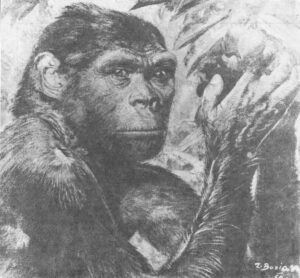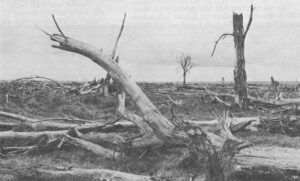Boyce Rensberger
- 1973

Fellowship Title:
- Man's Acheological Past and Ecological Present in Africa
Fellowship Year:
- 1973

Richard Leakey’s East Rudolf: Desolate Graveyard of Early Man
Koobi Fora, Kenya On this barren, crocodile-infested spit of sand that juts into Kenya’s remote Lake Rudolf stands the base camp of the most successful early-man fossil-hunting expedition ever mounted. From the semi-permanent grass-roofed huts clustered on the point to catch lake breezes, Richard Leakey and a team of scientists that sometimes swells to two dozen range out over a thousand square miles of hot, hilly thorn-bush country to collect the fossilized bones of various ancestors and cousins of the human species. In the six years since young Leakey, son of the pioneering couple, laid claim to what is now known as East Rudolf, he and his colleagues have recovered the partial remains of 110 individuals who lived anywhere from 1.3 to 4.0 million years ago and who stood very close to, if not actually in man’s ancestral lineage. Unlike most other fossil grounds in Africa, East Rudolf yields not just scattered fragments of bones but, perhaps due to unusual conditions of preservation, whole intact skulls and complete long limb bones. Leakey’s people have

American-Style Pollution Comes to Kenya
From the road that runs over nearby hills one can look out over Kenya’s Lake Nakuru and see a ribbon of pink fringing virtually the entire shoreline. The “pink” is all you can see from that distance of the hundreds of thousands — sometimes over a million — flamingoes that live in this remarkable lake habitat. The shallow margin of Lake Nakuru provides ideal conditions for the world’s largest concentration of flamingoes. It is also concentrating pesticides that may kill the birds. One can walk for miles along the shore, assailed by the constant gabble of thousands of closely herding flamingoes always within earshot. All day long they stilt through the shallows, swishing their beaks back and forth under the water to filter out the algae that is their chief food. Living in and around the same lake are tens of thousands of white pelicans, thousands of cormorants, herons and storks and varying numbers of some 400 other species of birds. Roger Tory Peterson, the ornithologist, once called Lake Nakuru, “the world’s most fabulous bird

South Africa’s Helen Suzman, Conscience of a Troubled Land
by Judy Rensberger
Johannesburg, South Africa In 1952 Helen Suzman seemed a poor bet to become South Africa’s most vilified and yet most internationally admired politician. She was young and pretty, rich and social, and the golf-playing wife of a Johannesburg doctor. Helen Suzman, South Africa’s lone anti-apartheid M.P., in her office at home. She ran for Parliament mostly because her husband thought it was a good idea, she did not expect to win, and — if the low keyed tone of her first campaign literature was any clue – perhaps she didn’t even care. She did win, however, and she has won ever since. Today Mrs. Suzman is the only national office-holder unalterably opposed to her country’s notorious “apartheid” form of government. Outnumbered in Parliament by 165 to 1, she is the lone but eloquent advocate of civil rights and equal opportunity for blacks — and a more unpopular cause in South Africa is difficult to imagine. “She has now got the name for being the official mouthpiece of permissiveness and all subversive activities in South Africa,”

The Killer Ape is Dead
Thirteen years ago Robert Ardrey published his African Genesis, popularizing Raymond Dart’s old theory that man evolved from a “killer ape” whose murderous instincts remain deeply ingrained in us, despite a veneer of civility. This angry beast is redrawn from the dust jacket of African Genesis. Although it does not look like any ape-man Ardrey discussed, it no doubt conveyed the desired emotional message. For many of the thousands who read the book and of the millions who heard about it, the theory remains a chilling but plausible explanation for the brutality of modern man. The theme of man’s innate depravity has been further dramatized in such works as William Golding’s Lord of the Flies. The idea even offers some escape from guilt: We are born this way and we can’t help it. The killer ape hypothesis, however, is an idea whose time has gone. In fact, most of the leading scientists who study the evolution of man say the theory never was accepted. Despite Ardrey’s skillful use of his dramatist’s talents to tell a

Nature ‘Spoils’ a Wildlife Paradise
Perhaps the best known and most enduring single feature of East Africa is the massive, snow crested mound of Kilimanjaro, rising through the clouds to over 19,000 feet. In the foreground of many thousands of tourists’ photographs of the mountain, however, is one of the most fragile and transitory features of Africa — the splendid yellow-barked acacia woodlands of Amboseli with herds of elephant or zebra or giraffe spectacularly silhouetted against the mountain. For some 20 years the once lush vegetation of Amboseli has been gradually dying, turning parts of Kenya’s most profitable game park into a barren landscape and threatening to destroy much of what remains of one of Africa’s best wildlife viewing areas. Since 1950 some 90 percent of the trees have died. Scrubby bushes have taken their place and the change in habitat may lead to a decline in the game animals for which Amboseli is famous. Much of the part of Amboseli that has had the most animals and tourists now looks like this. Although the destruction of the habitat has
